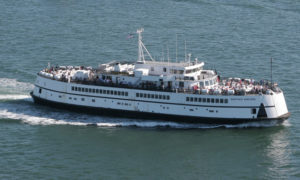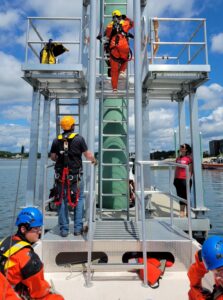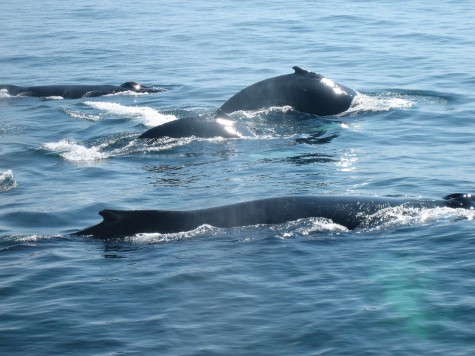
Whale watching on Cape Cod is the best way to experience the area’s unique natural landscape, species diversity and nautical history – all in one salt-tinged outing! The local whale watching season lasts between Mid-April and late October, providing you with the most ideal weather for observing the largest mammals on earth. However, whales can be spotted off the Cape’s coast year-round.
Types of Whales You May See in Cape Cod Waters
Here’s a list of whales you’re most likely to see on a Cape Cod whale watch.
Humpback Whales – These acrobatic creatures give whale watchers a run for their money: they’re well known “breachers” – that is, they tend to leap out of the water in a splashy spectacle that makes whale watching on Cape Cod such an intense experience. They are one of the more noisy species in Cape waters, with songs that can last for minutes at a time. A combination of slow swimming speed, abundance in Cape waters and playfulness unlike other species make these whales a must-see on any whale watch. Most Humpbacks range between 38 and 50 feet in length, and have the largest pectoral fins in the ocean, measuring up to 12 feet long. According to the National Oceanic and Atmospheric Administration (NOAA), most of a Humpback’s diet consists of krill, small fish and plankton. They can eat up to 3,000 pounds of food per day.
Finback Whales – NOAA says the Finback Whale is the second-largest, with lengths up to 75 feet and a weight of 40 to 80 tons. They may be larger than Humpbacks, but they can swim a lot faster with their streamlined, v-shaped head. They can also live longer, up to 80 or 90 years. Their massive size is second only to the Blue whale, which Finbacks have been known to occasionally mate with, producing hybrids. Like the Blue whale, the sounds Finbacks make are among the lowest-frequency sounds
made by any animal on earth. The Finbacks and Humpbacks both eat only during the summer time, providing whale watchers with quite a show as they filter krill, small fish and squid through baleen plates on the sides of their mouths.
Minke Whales – The smallest of the first three species, these whales can grow up to 35 feet long. Their comparatively diminutive size doesn’t impede their sense of curiosity though: like Humpbacks, the Minke (pronounced “Min-key”) whales are naturally curious and will sometimes approach idle crafts. Before diving deep, they’ll display long arches in their backs as they begin to dive, and stay submerged for up to 15 minutes at a time. Minke sounds include various clicks, grunts and “boings.” Krill, plankton and small schooling fish make up most of the Minke’s menu.
Pilot Whales – These 20-foot-long whales are much more sociable than the previous three, in that they tend to travel in larger groups of up to 20 individuals. Pilots are easily identified by their melon-shaped head and stocky body. These whales relate more to dolphins than do the other whales, and can even associate with some species of shark. According to NOAA, they can dive way down into 2000-foot depths to feed on dogfish, cod and other species. Luckily for whale watchers, these feedings mostly occur at night.
Right Whales – Many watchers revel in the opportunity to see these whales, as there sadly aren’t many of them left, numbering only about 450 in the North Atlantic. Right whales are considered endangered due to a number of factors: NOAA lists ship collisions, fishing gear entanglement and habitat loss as the primary ones, which is why your whale watch crew may keep a greater distance if Rights are spotted. No matter, they’re gorgeous creatures to watch from any distance, with jet black coloring and a size relative to a school bus. Rights only eat zooplankton, and do so by keeping their mouths open while skimming through patches of the small aquatic plants.
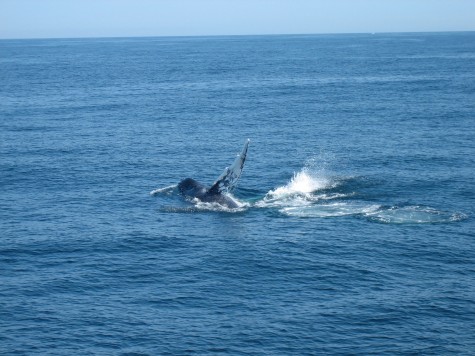
Whale Watching Costs
The cost of whale watching on Cape Cod can vary by season, group size and location. Expect an average of $46.75 for adults and $22.25 for children, with exceptions for veterans and seniors. These prices are subject to change during peak- and off-seasons. Many locations offer discounts through advertising promotions and coupons, so keep an eye out for those when shopping locally.
Where To Go Whale Watching on Cape Cod
Provincetown whale watching combines breathtaking aquatic scenery with the experience of “America’s First Destination.” There are multiple whale watching companies and their boats to choose from, all awaiting your arrival at Long Point Marina in Provincetown Harbor. Whale watching here has a definite advantage: the surrounding waters are known for a high whale population, and the companies that bring you to them all work together to follow regulations and maintain a safe distance. Watchers will see the overlooking Pilgrim Monument as they depart the harbor for Stellwagen Bank. Scour the seas for Humpback, Finback, Minke, and sometimes Right whales, and the occasional dolphin, porpoise and seal. You may even learn a thing or two about Provincetown’s whaling history as you observe the very species that were targeted for their meat, oil and blubber. Of course, you’ll also learn about how today’s scientists free entangled whales from fishing equipment and monitor their migration habits.
Barnstable whale watching has the advantage of location: boats out of Barnstable Harbor are much closer to the Bourne and Sagamore bridges than the roughly three hour ride to Provincetown from the Upper Cape. Cape Cod whale watches from this location are directly accessible from Route 6 and are close to one of the Cape’s largest tourist centers, downtown Hyannis. Watches out of Barnstable cruise through Cape Cod Bay, one of the prime areas to spot endangered Right Whales, and pass by picturesque Sandy Neck heading out and returning from the excursions.
For a more intimate setting, consider booking a private whale watch. These are available from both Provincetown and Barnstable ports, and offer smaller or custom group size and often a skipper who has more experience cruising Cape waters.
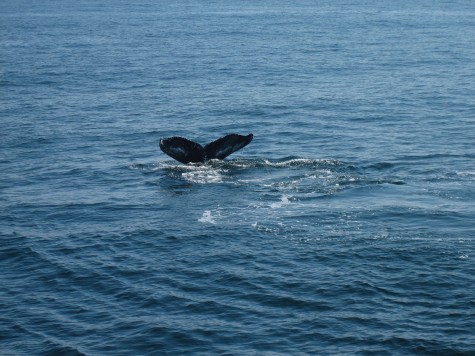
Whale Watching Times
Whale watching on Cape Cod is mostly a daytime event, though many services take advantage of the area’s beautiful sunsets to cap off their outings and return after dusk. Watches will last 3 to 4 hours almost without exception; private watches can last longer.






